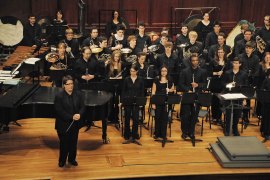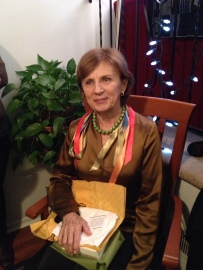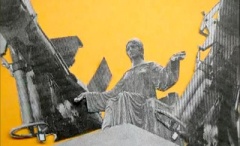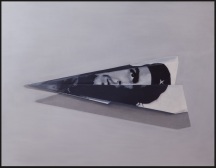Junior Art Education major Scott Samuels wraps up the Spring 2014 semester in his latest blog post on the process behind his and his classmates’ 10-foot murals created in Professor Thielker’s Advanced Painting course. The TCNJ student exhibition Young Galaxy is currently on display at ARTWORKS Trenton now through Saturday, May 3, 2014
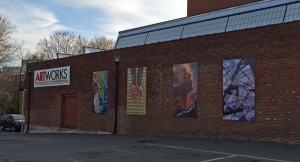 In Professor Gregory Thielker’s Advanced Painting class, we have spent the last month creating four 10-foot murals for the side of the ARTWORKS Visual Arts Center in downtown Trenton, NJ. Bringing these large-scale paintings into existence meant engaging in activities absent from traditional painting classes but integral to the creation of public art, like meeting with members of the local community and asking area businesses for donations. The mission of ARTWORKS is to “promote artistic diversity by fostering creativity, learning, and appreciation of the arts.” Essentially, ARTWORKS builds community by offering art classes, exhibitions, and events, making art accessible to everyone.
In Professor Gregory Thielker’s Advanced Painting class, we have spent the last month creating four 10-foot murals for the side of the ARTWORKS Visual Arts Center in downtown Trenton, NJ. Bringing these large-scale paintings into existence meant engaging in activities absent from traditional painting classes but integral to the creation of public art, like meeting with members of the local community and asking area businesses for donations. The mission of ARTWORKS is to “promote artistic diversity by fostering creativity, learning, and appreciation of the arts.” Essentially, ARTWORKS builds community by offering art classes, exhibitions, and events, making art accessible to everyone.
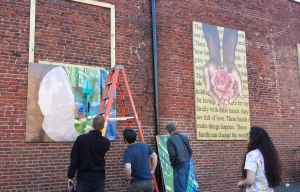 The first phase of our intellectual process was meeting with various local figures at TCNJ’s Trenton classroom. Included in the forum were Lauren Otis and Addison Vincent, two artists working at ARTWORKS, as well as Trenton-based Derrick Branch and Michael Kember. Organized by Professor Thielker, this meeting of minds was designed to give us an idea of the pulse of Trenton, inspire our artmaking, and kick-start the design process. Over the following week, each member of the class produced seven mural designs that would be critiqued and nominated for placement on the wall.
The first phase of our intellectual process was meeting with various local figures at TCNJ’s Trenton classroom. Included in the forum were Lauren Otis and Addison Vincent, two artists working at ARTWORKS, as well as Trenton-based Derrick Branch and Michael Kember. Organized by Professor Thielker, this meeting of minds was designed to give us an idea of the pulse of Trenton, inspire our artmaking, and kick-start the design process. Over the following week, each member of the class produced seven mural designs that would be critiqued and nominated for placement on the wall.
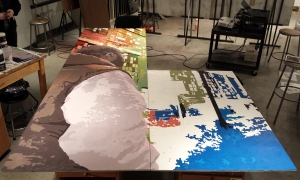 My group chose a digitally-rendered design produced by Ashley Garguilo, which depicts local muralist and activist Will “Kasso” Condry gazing down a Trenton street. The buildings are illustrated in bright, rainbow hues, suggesting that where others simply see a dilapidated structure, Kasso sees a blank canvas. With our design chosen, we wrote a printed proposal that would serve as an introduction to and overview of our mural. Included in this document were the date and location of installation, a small image of the artwork, and a brief background on what a mural is. We also explained a bit about ARTWORKS Trenton, and listed exactly what supplies we needed so we could distribute the proposal to local stores. With several copies of the proposal in hand, we visited the Jerry’s Artarama of Princeton to explain our project and ask for donations, whereupon the Outreach Director Lisa Thomas was generous enough to let us have eight large tubs of acrylic paint.
My group chose a digitally-rendered design produced by Ashley Garguilo, which depicts local muralist and activist Will “Kasso” Condry gazing down a Trenton street. The buildings are illustrated in bright, rainbow hues, suggesting that where others simply see a dilapidated structure, Kasso sees a blank canvas. With our design chosen, we wrote a printed proposal that would serve as an introduction to and overview of our mural. Included in this document were the date and location of installation, a small image of the artwork, and a brief background on what a mural is. We also explained a bit about ARTWORKS Trenton, and listed exactly what supplies we needed so we could distribute the proposal to local stores. With several copies of the proposal in hand, we visited the Jerry’s Artarama of Princeton to explain our project and ask for donations, whereupon the Outreach Director Lisa Thomas was generous enough to let us have eight large tubs of acrylic paint.
Our artistic process commenced with a trip to Home Depot, where each group purchased four 5’x3’ cement boards, for a final dimension of 10’x6’. We primed the front, back, and sides of the boards, then used a digital projector to trace each quarter of the design onto the panels. We printed each quadrant of the design in color on large paper to use as a color reference, and began mixing paint, filling in the shapes like a paint-by-number. In two short yet very busy weeks, the mural was complete, and we painted our names and sponsor at the bottom, then coated the panels with a thick layer of glossy varnish to protect against weathering and ultraviolet light.
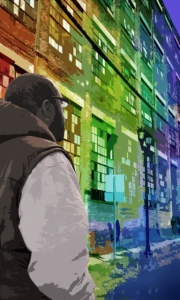 When it came to installation, our dedicated professor attached wood frames to the ARTWORKS building’s brick façade, into which we screwed the mural panels. This was by far the most unnerving stage of the process, as a crew of five people lifted the heavy cement boards one at a time on a tall ladder and screwed them in amidst a steady wind. Besides the weight of the boards, the most difficult task was lining the panels up precisely so that the paintings flowed seamlessly from one to the next. Needless to say, our mural project was a unique and fascinating learning experience, which exposed us to topics and activities we would not have seen in a normal painting class. The murals are part of the Young Galaxy exhibition currently up at ARTWORKS, which features fresh works from TCNJ’s advanced students, including drawings, videos, sculptures, and installations. The show will be up through May 3rd, and I strongly encourage all who can to stop in and visit. You will know you are in the right place when you see four vibrant murals jump out at you.
When it came to installation, our dedicated professor attached wood frames to the ARTWORKS building’s brick façade, into which we screwed the mural panels. This was by far the most unnerving stage of the process, as a crew of five people lifted the heavy cement boards one at a time on a tall ladder and screwed them in amidst a steady wind. Besides the weight of the boards, the most difficult task was lining the panels up precisely so that the paintings flowed seamlessly from one to the next. Needless to say, our mural project was a unique and fascinating learning experience, which exposed us to topics and activities we would not have seen in a normal painting class. The murals are part of the Young Galaxy exhibition currently up at ARTWORKS, which features fresh works from TCNJ’s advanced students, including drawings, videos, sculptures, and installations. The show will be up through May 3rd, and I strongly encourage all who can to stop in and visit. You will know you are in the right place when you see four vibrant murals jump out at you.

